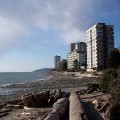Only a few families lived in Horseshoe Bay year-round until Dan Sewell arrived in 1931 and opened his marina and the Whytecliff Lodge. Electricity had arrived in 1922; direct telephone to Vancouver in 1928. But by 1930 Only 48 of West Van's 100 kilometres of road were paved. Many streets still lack sidewalks and longtime residents prefer it that way.
In 1926 West Van's council lowered the boom on what little logging and fish canning remained. The 1926 town planning act banned any new industry, opting for an exclusively residential municipality with minimum lot sizes. The Millerd family ran the Great Northern Cannery, built in 1891, until 1967. It is now the site of Environment Canada's Pacific Research Laboratories. West Van's new policy ultimately saved its goose. It caught the eye of Ireland's wealthy Guinness family during the Depression. The Guinness' British Pacific Syndicate paid less than $50 a hectare for 1,600 scenic hectares on Hollyburn Ridge to develop as the prestigious British Properties around the Capilano Golf and Country Club. In 1938 they built the $6 million Lions Gate Bridge in order to increase lot sales. Fifty years after the start of construction Guinness would add lights as an Expo 86 gift. The familiar British slogan "Guinness is good for you" could well have become West Van's civic motto. King George VI and Queen Elizabeth drove across in 1939 to officially open the British Empire's longest suspension bridge. By 1947 the ferries had stopped. The little 1913 ferry building became a bus depot, then a community gallery.
It was individual houses that ultimately put West Van on the map. From 1945 to 1975 West Vancouver was a centre of award-winning Canadian residential design (inspired by the natural landscape) that culminated in the approach recognized as the "West Coast Style." There are literally hundreds of modern houses by such designers and architects as C.B.K. Van Norman, John Porter, Ned Pratt, Arthur Erickson, Fred Hollingsworth and Ron Thom.
In 1959 rezoning of some 20 hectares permitted 78 high-density apartments in Ambleside. The Crescent Apartments (1961) was West Van's first high-rise condominium. Some along the waterfront-notably Villa Maris, aka "Pink Palace"-are in Miami pastels. West Van is changing. New neighborhoods have spread across the so-called "Land Above the Upper Levels." West Van's beloved 15-block seawall connects lively Ambleside and two-block long Dundarave, the latter still crowned by the British Properties, but now peppered with the Mandarin, Cantonese, German and Iranian accents of new residents. There are still familiar landmarks of West Van's heritage, many listed in the West Vancouver Heritage Inventory. Among them: Caulfeild's charming St. Francis-in-the-Woods Anglican Church (with William Morris windows) and Gertrude Lawson's house (now the West Vancouver Museum and Archives), built of stone carried as ship's ballast from New Zealand. Other bits of West Van's history survive. Chief Joe Capilano, who travelled to London in 1906 to discuss Indian land rights with King Edward VII, overlooks Park Royal from his Keith Road mausoleum. A grove of eight apple trees and one cherry tree near the sixth hole of Gleneagles Golf Course are remnants of the Peter Larson Ranch. The leafy canopy of horse chestnut trees on 17th Street was planted in 1934 by Boy Scouts to commemorate the visit of Lord Baden-Powell.
Best of all, enthusiastic residents still exercise a pioneer sense of fun! Each year they head like happy lemmings for both the Capilano River Duck Race that sends 30,000 yellow rubber duckies bobbing down the Capilano for charity, and the Coho Festival, which celebrates the return of the salmon that spawn up the same river. They fish and stroll the three ferry-less piers.
Citizenry block off Marine Drive at the drop of a hat; and do so for the August Dundarave Hoe Down, June's Community Day Parade and on Remembrance Day. Veterans march, Harvards fly overhead, the band plays, tears are shed, wreaths laid and tea and cookies served in the library for all. Around that stone memorial, as Bruce Ramsey notes in "A Place of Excellence," his chronicle of West Vancouver, have stood medal-bedecked men who saw service in Canada's Northwest Rebellion, India's Northwest Frontier, the Zulu campaigns leading to the Boer War, World War I and World War II, as well as Korea, the Suez, Vietnam, Cyprus and Bosnia. For all the changes, West Vancouver is still a good place to return home to.

